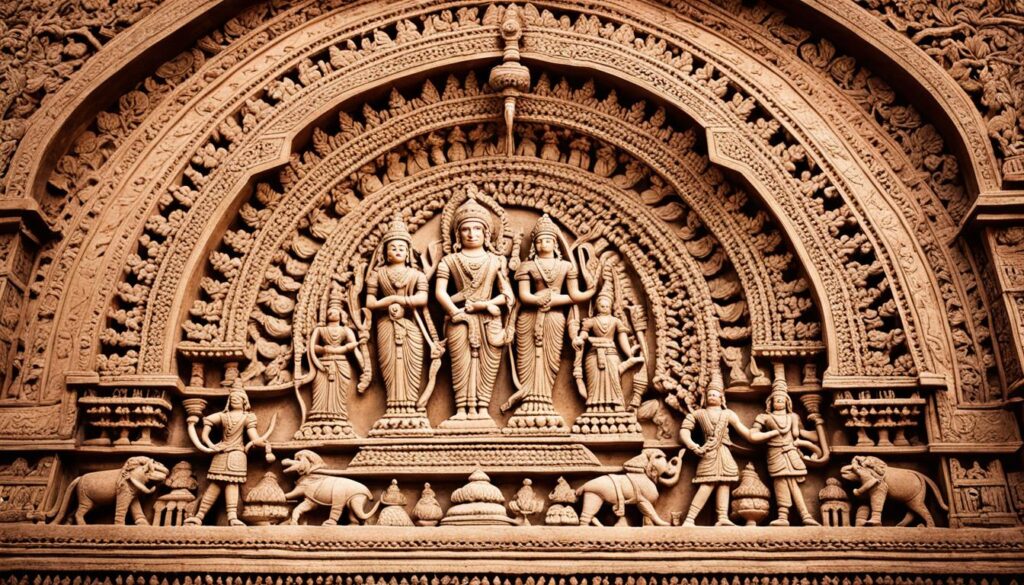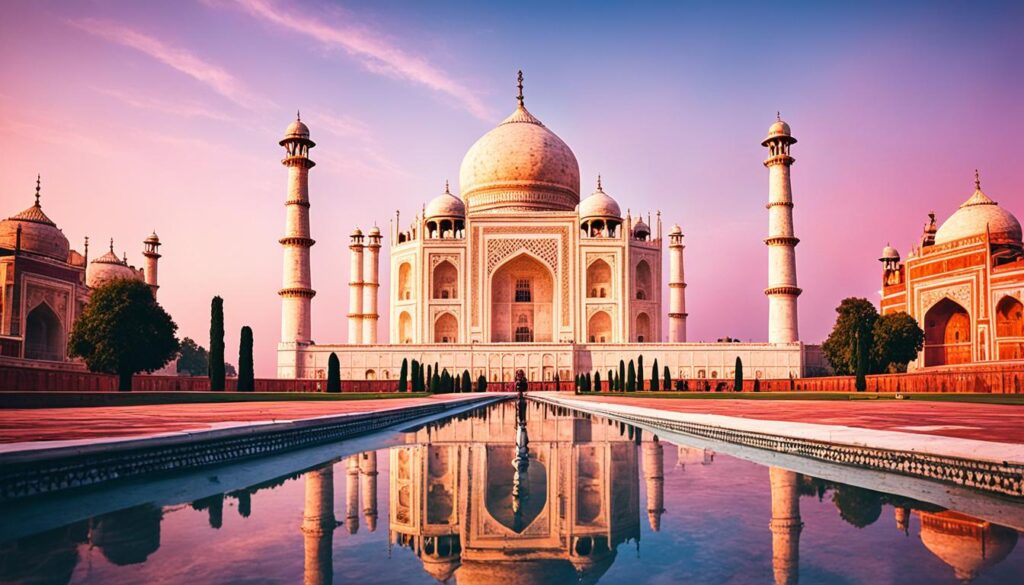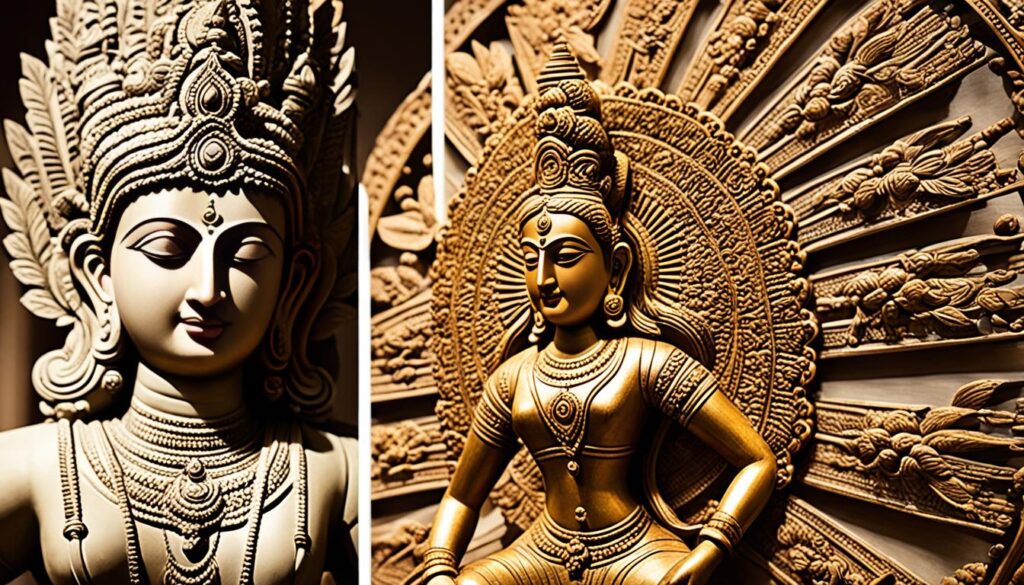Did you know that India is home to some of the most iconic and historically significant sculptures in the world? These exquisite works of art have captivated people for centuries, showcasing India’s rich cultural heritage and artistic excellence. From ancient sculptures that depict mythological tales to modern creations that blend tradition and innovation, Indian sculptures offer a glimpse into the country’s diverse artistic traditions. Join us as we delve into the world of famous sculptures in India and discover the stories they tell.
Key Takeaways:
- India is renowned for its famous sculptures that reflect its rich cultural heritage.
- Indian sculptures range from ancient masterpieces to contemporary creations.
- These sculptures depict religious, mythological, and cultural themes.
- Iconic sculptures in India have played a crucial role in shaping the country’s history and culture.
- India’s famous sculptures attract millions of tourists, boosting the country’s economy.
The Quintessence of Indian Sculptural Art
The Diversity of Traditional Indian Art
Traditional Indian art is a vibrant tapestry that weaves together the diverse cultural heritage of the country. Passed down through generations, it encompasses a wide range of artistic styles and techniques, showcasing the deep-rooted beliefs and traditions of the Indian people. Each region of India boasts its own distinctive style of sculptural art, reflecting the rich diversity that exists within the country. From the intricately carved temples of the North to the awe-inspiring rock-cut sculptures of the South, traditional Indian art is a testament to the skill and creativity of its artisans.
A Journey Through Ancient Sculptures
Ancient sculptures in India not only serve as artistic masterpieces but also offer valuable insights into the country’s history, culture, and society. These sculptures, with their intricate details and lifelike expressions, tell the stories of ancient civilizations, depict gods and goddesses, and provide glimpses into everyday life in antiquity. Through the artistry of ancient sculptors, we are transported back in time and given a window into the cultural and social fabric of India’s past. These sculptures stand as monuments to the craftsmanship and vision of long-gone artists, preserving their legacy for generations to come.
Table: Examples of Ancient Sculptures in India
| Sculpture | Region | Significance |
|---|---|---|
| The Great Stupa of Sanchi | Madhya Pradesh | One of the oldest stone structures in India, an important Buddhist pilgrimage site. |
| Ashoka Pillars | Various regions | Erected during the reign of Emperor Ashoka, symbolizing peace and spreading his teachings. |
| Nataraja | Tamil Nadu | A bronze statue representing Lord Shiva as the cosmic dancer, highlighting the grace and energy of the deity. |
These examples are just a glimpse of the vast array of ancient sculptures that dot the Indian landscape. Each sculpture holds a unique story and contributes to the rich tapestry of Indian art and history.
Iconic Indian Sculptures and Their Historical Significance
India is home to many iconic sculptures that hold great historical significance. These sculptures have played a crucial role in shaping India’s history and culture, preserving stories and traditions for future generations.
The sculptures at the Khajuraho Temples are renowned for their intricate carvings and explicit depictions. They represent the rich artistic and cultural heritage of India, showcasing the skill and craftsmanship of ancient Indian sculptors.
The Ellora Caves, with their rock-cut sculptures, are another testament to India’s diverse history and religious harmony. These sculptures showcase the coexistence and amalgamation of different religious beliefs in ancient India.
The Chola Bronzes are considered some of the finest pieces of sculptural art in the world. These bronzes are renowned for their intricate details and lifelike expressions, reflecting the mastery of Chola sculptors and their ability to capture the essence of human emotion.
These iconic Indian sculptures not only serve as visual representations of India’s past but also provide valuable insights into the historical, cultural, and religious traditions of the country. They continue to inspire awe and fascination among art enthusiasts and tourists alike, showcasing the artistic excellence and historical significance of Indian sculpture.
![]()
Famous Sculptures in India: A Testament to Architectural Marvel
UNESCO World Heritage Sites and Sculptural Wonders
When it comes to architectural marvels and sculptural wonders, India is a treasure trove of cultural heritage. The country is home to numerous UNESCO World Heritage Sites that showcase magnificent sculptures and breathtaking architecture. These sites, with their intricate carvings and awe-inspiring designs, bear witness to India’s rich artistic legacy.
One such prominent example is the Khajuraho Temples, located in Madhya Pradesh. These temples are famous for their exquisite sculptures depicting various aspects of life, love, and spirituality. **UNESCO World Heritage Sites**, these temples offer a glimpse into the artistic genius of ancient India and attract a large number of tourists from around the world.
Another iconic masterpiece is the world-renowned Taj Mahal, located in Agra. This architectural marvel is not only a testament to the love of Emperor Shah Jahan for his wife Mumtaz, but it also showcases impeccable craftsmanship and intricate detailing. The Taj Mahal’s grandeur and beauty make it a top destination for tourists visiting India, contributing significantly to **tourism** and the country’s **economy**.
The Konark Sun Temple in Odisha is yet another mesmerizing example of Indian sculptural wonders. This UNESCO World Heritage Site is dedicated to the Sun God and is renowned for its intricate stone carvings that depict various mythological stories and celestial beings. The temple’s architectural brilliance and artistic finesse continue to captivate visitors and serve as a testament to India’s rich cultural heritage.
Tourism and Economy: The Impact of Indian Statues
The rich heritage of famous sculptures in India has a significant impact on the country’s **tourism** industry and **economy**. The awe-inspiring beauty of these sculptural wonders attracts millions of tourists every year, contributing to the growth of the tourism sector in India.
Tourists visiting India to explore its iconic sculptures not only generate revenue for the local communities but also contribute to the overall economic development of the country. The influx of tourists creates job opportunities, boosts local businesses, and stimulates various sectors of the economy, such as hospitality, transportation, and handicrafts.
The revenue generated from tourism plays a crucial role in preserving and maintaining these historic sculptures. It enables the authorities to undertake conservation and restoration projects, ensuring that these sculptural treasures continue to be cherished for generations to come.
Overall, the impact of Indian statues on tourism and the economy underscores the value and significance of preserving and promoting India’s rich sculptural heritage.

Region-wise Celebration of Sculptural Heritage
The sculptural heritage in India varies across different regions, each with its unique artistic expressions. From the architectural marvels of Northern India to the grand temples and statues of Southern India, the country boasts a rich tapestry of sculptural traditions.
Gems of Northern India: From Taj to Jantar Mantar
When it comes to Northern India, two iconic landmarks immediately come to mind—the Taj Mahal and the Jantar Mantar. The Taj Mahal, located in Agra, is renowned for its exquisite marble craftsmanship and breathtaking beauty. This UNESCO World Heritage Site stands as a testament to eternal love and is one of the most visited and photographed monuments in the world. Its intricately carved walls and delicate inlays are a testament to the mastery of Indian sculptors.

Another marvel in Northern India is the Jantar Mantar, an astronomical observatory in Jaipur. This collection of nineteen architectural instruments was built in the 18th century and showcases the scientific knowledge and precision of ancient Indian astronomers. The Jantar Mantar is a remarkable fusion of art and science, with each instrument carefully designed to calculate and measure various celestial phenomena.
The Artistic Pillars of Southern India: Temples and Statues
Stepping into Southern India reveals a different facet of India’s sculptural heritage. The region is famous for its magnificent temples adorned with ornate sculptures that depict mythological scenes and deities. One such temple is the Meenakshi Temple in Madurai, dedicated to Lord Shiva and his consort, Goddess Meenakshi. The temple is a masterpiece of Dravidian architecture, with its towering gopurams (ornate gateways) adorned with intricate sculptures showcasing the rich mythology and cultural traditions of the region.
Another architectural wonder of Southern India is the Brihadeeswarar Temple in Thanjavur. This temple, also known as the Big Temple, is a marvel of Chola architecture and features one of the tallest temple towers in India. The temple complex is home to numerous exquisite sculptures, including the famous Nandi bull statue. The intricate details and lifelike expressions of the sculptures demonstrate the skill and craftsmanship of Indian sculptors.
These regions, with their architectural wonders and artistic traditions, provide a glimpse into the diverse and captivating world of Indian sculpture.
Modern Influence and Preservation of Indian Sculpture
Indian sculpture has not remained stagnant in the modern era, but rather, it has evolved and adapted to contemporary influences. Today, modern artists in India are pushing the boundaries of traditional sculptural art, exploring new techniques, materials, and themes. This continuous exploration and experimentation keep the art form alive, vibrant, and relevant to the present times.
The fusion of traditional and modern elements in Indian sculpture has become a hallmark of the country’s thriving art scene. Artists are blending age-old techniques with contemporary aesthetics, creating unique pieces that capture both the essence of ancient traditions and the spirit of modern innovation. This interplay between tradition and modernity allows Indian sculpture to transcend time and connect with audiences from different eras.
Preserving and protecting ancient sculptures is essential to maintain India’s rich cultural heritage. Conservation projects and initiatives are underway to safeguard these invaluable artworks for future generations. Through careful restoration, documentation, and museum display, ancient sculptures are being preserved as a testament to India’s artistic legacy.

The efforts to preserve Indian sculpture go hand in hand with the promotion of awareness and appreciation for this art form. Public exhibitions, educational programs, and digital platforms play a crucial role in showcasing the beauty and significance of Indian sculptures to a wider audience. By fostering an understanding of their historical and cultural importance, preservation efforts ensure that Indian sculpture continues to be celebrated and cherished.
The preservation and modern influence of Indian sculpture contribute to its continuity and relevance in the modern world. This dynamic art form, with its deep roots and ever-evolving nature, continues to inspire awe and admiration, capturing the imagination of both art enthusiasts and the wider public.
Conclusion:
The magnificence of Indian sculptures is a testament to the country’s rich heritage, artistic excellence, and cultural diversity. From ancient times to the present day, these sculptures continue to capture our imagination and inspire awe. They offer a window into India’s storied past and provide valuable insights into its history, culture, and society.
By preserving and celebrating these sculptures, we not only honor India’s cultural legacy but also contribute to the understanding and appreciation of its artistic heritage. These masterpieces, whether it’s the intricate carvings at the Khajuraho Temples or the lifelike expressions of the Chola Bronzes, serve as a visual reminder of the immense talent and craftsmanship that thrived in ancient India.
From the grandeur of the Taj Mahal to the ornate sculptures adorning Southern India’s temples, the influence of Indian sculptures can be felt across the country. These sculptures not only captivate tourists from around the world but also contribute significantly to India’s tourism industry, boosting the country’s economy in the process.
Indian sculpture is an art form that has evolved and adapted to contemporary influences, ensuring its relevance in the modern world. By combining traditional techniques and themes with modern elements, artists continue to breathe new life into this ancient art form. Efforts are also being made to conserve and protect the country’s historic sculptures, safeguarding them for future generations to appreciate.
FAQs:
Q: What is traditional Indian art?
A: Traditional Indian art encompasses a wide range of artistic styles and techniques that have been passed down through generations. It incorporates religious, mythological, and cultural themes, showcasing the deep-rooted beliefs and traditions of the Indian people.
Q: What do ancient sculptures in India depict?
A: Ancient sculptures in India are artistic masterpieces that provide valuable insights into the country’s history, culture, and society. They tell stories of ancient civilizations, depict gods and goddesses, and portray everyday life in ancient times.
Q: What are some famous Indian sculptures?
A: India is home to many iconic sculptures that hold great historical significance. The sculptures at the Khajuraho Temples represent the rich artistic and cultural heritage of India. The Ellora Caves showcase the harmony between different religious beliefs. The Chola Bronzes are considered some of the finest pieces of sculptural art in the world.
Q: What are some famous sculptural wonders in India?
A: India is home to numerous UNESCO World Heritage Sites that boast magnificent sculptures and architectural marvels. The temples of Khajuraho, the Taj Mahal, and the Konark Sun Temple are just a few examples of these sculptural wonders.
Q: How do Indian sculptures contribute to the tourism industry?
A: The sculptural wonders in India attract millions of tourists every year, contributing significantly to the country’s tourism industry and boosting its economy.
Q: What regions in India are famous for their sculptural heritage?
A: Northern India is known for architectural marvels like the Taj Mahal and the Jantar Mantar, showcasing intricate craftsmanship and exquisite beauty. Southern India is famous for its grand temples, such as the Meenakshi Temple and the Brihadeeswarar Temple, adorned with ornate sculptures that depict mythological scenes and deities.
Q: How is traditional Indian sculpture evolving in the modern era?
A: Indian sculpture has adapted to contemporary influences, and modern artists continue to explore new techniques, materials, and themes, keeping the art form alive and relevant.
Q: What efforts are being made to preserve ancient sculptures in India?
A: Conservation projects and initiatives are being undertaken to preserve and protect ancient sculptures, ensuring that they are safeguarded for future generations.

I was just as enthralled by your work as you were. The visual display is refined, and the written content is of a high caliber. However, you seem anxious about the possibility of delivering something that could be perceived as questionable. I believe you’ll be able to rectify this situation in a timely manner.
I just like the helpful information you provide in your articles
You’re so awesome! I don’t believe I have read a single thing like that before. So great to find someone with some original thoughts on this topic. Really.. thank you for starting this up. This website is something that is needed on the internet, someone with a little originality!
This is my first time pay a quick visit at here and i am really happy to read everthing at one place